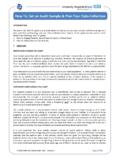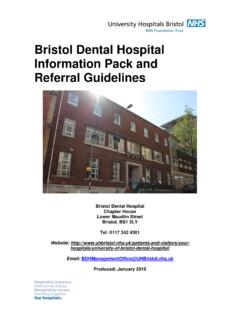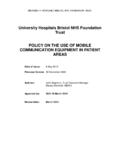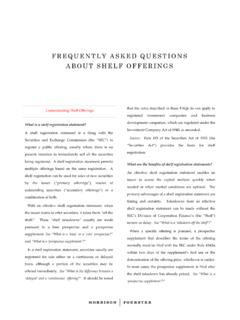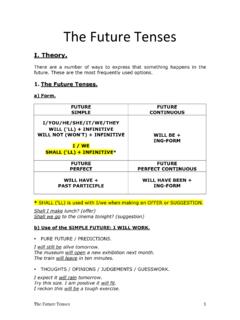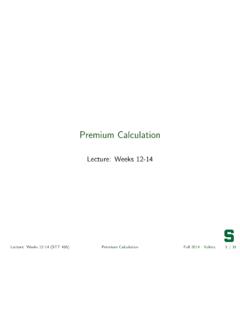Transcription of How To : Analyse & Present Data
1 2009 UHBristol Clinical Audit Team Version 3 Page 1 of 8 INTRODUCTION The aim of this How To guide is to provide advice on how to Analyse your data and how to Present it. If you require any help with your data analysis please discuss with your divisional Clinical Audit Facilitator who will be happy to help. 1. HOW TO Analyse DATA Audit data comes in three different forms, tick-box , numerical or freetext. Each requires different methods of analysis, but in each case the aim is to establish which standards are being met (% compliance) and which are not (% non-compliance). If a standard is not being met you need to identify why and how practice can be improved to ensure that the standard is met in the future.
2 You may also consider if there were other, acceptable reasons for the standard not being met, an exception not considered during the planning stage. A. TICK-BOX DATA It is likely that the majority of the data that you have obtained from your data collection form will relate to yes/no options or tick-box options from a specified list of alternatives. In such cases, it is usual practice to add up the number of answers recorded for each option and express the total as a raw number and as a percentage. EXAMPLE 1: Sample size: 50 patients Audit criteria: All patients should attend a pre-operative clinic Question: Did the patient attend a pre-operative clinic? Results: Yes = 32 and No = 18.
3 A good way of expressing this data is: All patients should attend a pre-operative clinic. n=50 Yes = 32 (64%) No = 18 (36%) The n=50 indicates how many patients were in the audit sample and is used to calculate the percentages, 32/50 = 64%. It is important to remember that yes/no options do not allow for not applicable answers. Taking the example used above, it is possible that certain patients did not meet the standard because they had an emergency operation. In this instance the answer to the question Did the patient attend a pre-operative clinic? would have been not applicable . To reflect this the data can be expressed more accurately as: How To: Analyse & Present Data x Number of patients who meet standard Number of patients to whom standard applies Number of patients who meet any listed exceptions 100 CALCULATING COMPLIANCE WITH CLINICAL AUDIT STANDARD 2009 UHBristol Clinical Audit Team Version 3 Page 2 of 8 How To: Analyse & Present Data EXAMPLE 2: Audit criteria: All patients should attend a pre-op clinic Exception: emergency operation Results.
4 Yes = 32, No = 13 and N/A (emergency) = 5 32 patients attended a pre-op clinic 18 did not, but 5 of these were emergencies (exception criteria) Therefore 32/45 (71%) met the standard B. NUMERICAL DATA Some of the data items you collect are likely to be numerical values, age, length of stay in hospital, blood glucose level etc. Lists of numbers like this can be summarised using measures of central tendency and dispersion: Measures of central tendency look at the middle/common values in a list of data items: the mean, median and mode. Measures of dispersion look at how spread the data is: the range. MEASURES OF CENTRAL TENDENCY The mean is the average value, calculated as: Sum of all the values Number of values The table below shows data about length of stay (LOS) on three wards: For Ward 1, the mean is: (1x4) + (2x8) + (3x12) + (4x18) + (5x20) + (6x18) + (7x12) + (8x8) + (9x3) = 511 = 4 + 8 + 12 + 18 + 20 + 18 + 12 + 8 + 3 103 The mean LOS on ward 1 is 5 days (rounded to nearest whole day).
5 If the same formula were used to calculate the means for wards 2 and 3, you will find that for each ward, the mean LOS is 5 days. However, the mean is not always the best measure of central tendency. The LOS for all three wards is illustrated on the graph below. The mean suggests that the data is the same for all three wards, however the graph indicates that this is not the case. The problem with the mean is what it does not tell us. Number of patients discharged Length of Stay (days) Ward 1 Ward 2 Ward 3 1 4 4 1 2 8 7 3 3 12 17 3 4 18 10 4 5 20 7 10 6 18 4 15 7 12 2 4 8 8 2 2 9 3 5 0 10 0 9 0 x 32 50 5 100 32 45 = 2009 UHBristol Clinical Audit Team Version 3 Page 3 of 8 How To: Analyse & Present Data The data collected for Ward 1 is almost perfectly symmetrical, with the graph illustrating that the data follows the shape of a bell curve.
6 Data that conforms to this shape is known as parametric data. In this instance the mean is an appropriate measure of central tendency. The data for Wards 2 and 3 is non-parametric. Their graphs do not form a symmetrical curve. Describing their notable features, Ward 2 has a significant proportion of patients with a LOS of 3 days together with a number of patients staying 9 or 10 days. Ward 3 has a peak LOS of 6 days. It can be seen that using the mean alone with non-parametric data is not very informative. The median and mode can help to convey the missing information. The mode is the most commonly occurring value. For Ward 2 this is 3 days and for Ward 3 it is 6 days. This should be obvious from both the raw data and the graph.
7 If the highest occurrence is shared by more than one value you could either state them all as modal values, or none. For example, if for Ward 3 there were 10 patients discharged on both day 5 and day 6 you could either say there were 2 modal values of 5 and 6, or that there was no mode. The median is the mid-point of all the values. For Ward 2, we have data on 67 patients. If we made a list of LOS, placed in order from the lowest to the highest, the mid-point would be the 34th value there are 33 values below and above this. The 34th value relates to a patient who was discharged after 5 days, so this is the median. For Ward 3, we have data on 42 patients, there is no single mid-point.
8 In this case, take the average of the 21st and 22nd value (there are 20 values below and above these two values). The 21st value relates to a patient who was discharged after 5 days and the 22nd value relates to a patient who was discharged after 6 days, so the median is days (5+6 divided by 2). Unless you are well versed in statistics, we would advise that you use all three measures of central tendency, or show the information using a graph. In general, quote median rather than mean for non-parametric data. Not all lists of numerical data should be analysed in this way. For example, if your standard is The patient will be considered medically fit for surgery if temperature <38 C and you collect a list of temperature data, it would not be meaningful to Present the mean, median and mode temperature.
9 What you are interested in here is the percentage of cases that met the standard the percentage of surgical cases with temperature <38 C. MEASURES OF DISPERSION As well as stating the mean, median and mode, it is also good practice to provide some indication of how spread the data is. The range states the lowest and highest values. In our example: Ward 1 has a range of 1-9 days Ward 2 has a range of 1-10 days Ward 3 has a range of 1-8 days Length of Stay051015202512345678910 DayNumber of patients dischargedWard 1 Ward 2 Ward 3 2009 UHBristol Clinical Audit Team Version 3 Page 4 of 8 How To: Analyse & Present Data A more subtle way of expressing dispersion is to use quartile range.
10 This involves listing your values from lowest to highest, as per calculating the median, and then dividing the values into four equal parts or sub-ranges. The range you are interested in lies between the second and third quarter (or quartile ). So, for example, some more LOS data: Ward C: 1 2 3 5 | 5 6 6 7 | 7 7 7 9 | 9 11 20 38 In this case the range is 1-38 days, but the quartile range is 5-9 days The quartile range is useful in taking out outlying data (data some distance away from the mean/median/mode), as in the case of Ward C above and Ward 2 in our first example. Ward 2 has the largest range but a comparable quartile range to Wards 1 and 3: Ward 1 - range 1-9 days; quartile range 4-6 days Ward 2 - range 1-10 days; quartile range 3-7 days Ward 3 - range 1-8 days; quartile range 4-7 days ANALYSING DATA AGAINST STANDARDS If your standard statement was Patients should be discharged by the end of their 5th day following surgery , using LOS data for ward 2, you find that 45 out of the 67 discharged patients had a LOS of 5 days or less.



